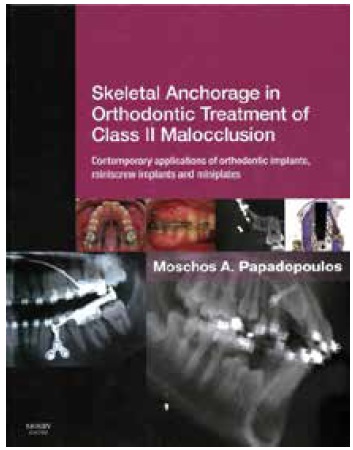Article
Skeletal Anchorage in Orthodontic Treatment of Class II Malocclusion
This book aims to provide information on all of the skeletal anchorage devices and techniques that are currently applicable to the treatment of Class II cases. It features contributions from 96 authors from across the world, including a large number of the best known names in the clinical application of orthodontic bone anchorage, and hence contains a lot of well-written and accurate information. The book is structured in nine sections containing a total of 52 relatively short chapters. Section I sets the ‘conventional’ scene with two chapters outlining the background and biomechanics of conventional anchorage systems used in Class II cases. In reality these two chapters may read better as a single amalgamated one, with more critical analysis (and references) of the anchorage limitations of both headgear and TPAs, and the mechanics and side-effects of the large variety of Class II correctors/distalisers mentioned. UK readers, familiar with Twin Block (removable) functional appliances will also view their unfavourable comparison with other Class II correctors as clinically inaccurate in terms of the exaggerated treatment times described, and under-emphasis of the lower incisor tipping produced by fixed functionals. However, the reader will still be able to discern the clear message that all non-compliance distalisers lose anchorage…… unless bone anchorage is added.
Section II describes the evidence base (in terms of RCTs), biological and structural basis, of skeletal anchorage fixtures, ie implants, mini-(screw) implants and mini-plates. Within this section, chapter four focuses on dental implant details, despite their relatively rare application for orthodontic anchorage today and, importantly, it misses the opportunity to clarify for most readers what the differences are between histological bone-implant contact and practical levels of osseointegration. In effect, why are mini-implants retentive rather than clinically integrated, and easy to remove? In addition, onplants are also described, despite these having been obsolete for almost two decades owing to their high failure rate and invasive (palatal flap) surgery.
Section IV deals with insertion procedures for the various skeletal anchorage fixtures, then the 29 chapters contained in sections V to VIII provide descriptions of the technical variations of bone anchored distalisers and Class II fixed-functional appliances. These are largely illustrated as case reports, where the reader is left to interpret the relative advantages and disadvantages of each technique in the context of their clinical caseload and experience. I found the illustrations of bone-anchored Class II correctors stimulating, although the preliminary skeletal changes reported (commendably) by Erverdi et al in chapter 24 were disappointing. Hopefully, further research will elucidate the factors which may optimize skeletal change in growing individuals.
Finally, the five chapters in section IX outline the potential complications of skeletal anchorage reinforcement, although arguably these chapters would flow better in the introductory sections earlier in the book. This disjointed chronology and repetition of content detracts from the volume of material contained in this book. Consequently, while this book provides orthodontists with information on a wide array of clinical techniques and bone anchored devices applicable to Class II cases, I think that it is most suitable as a reference text, and each reader needs to critique the relative merits of each technique and their applicability to their own orthodontic practice.

